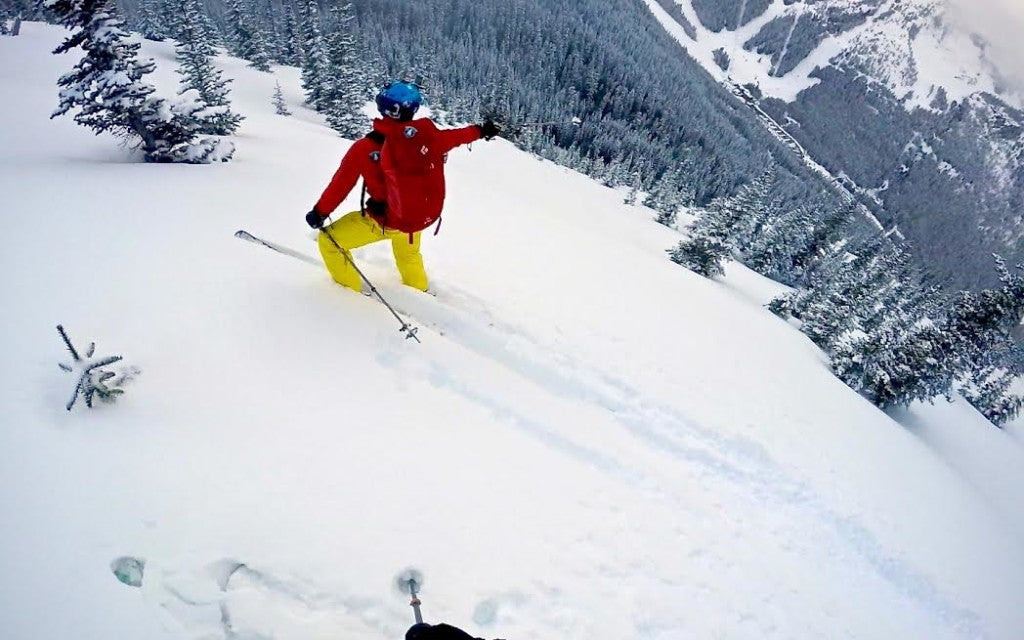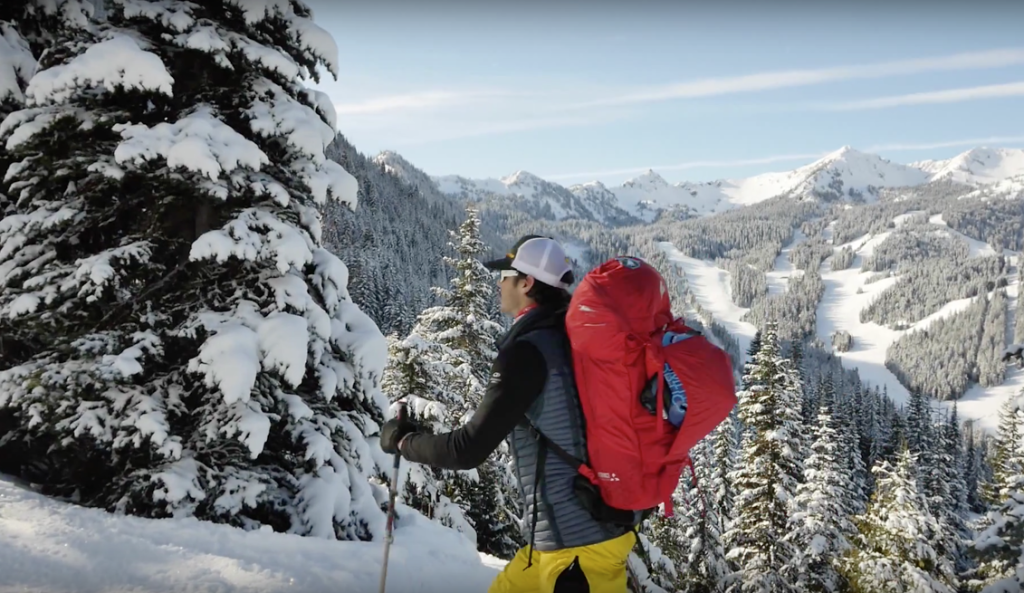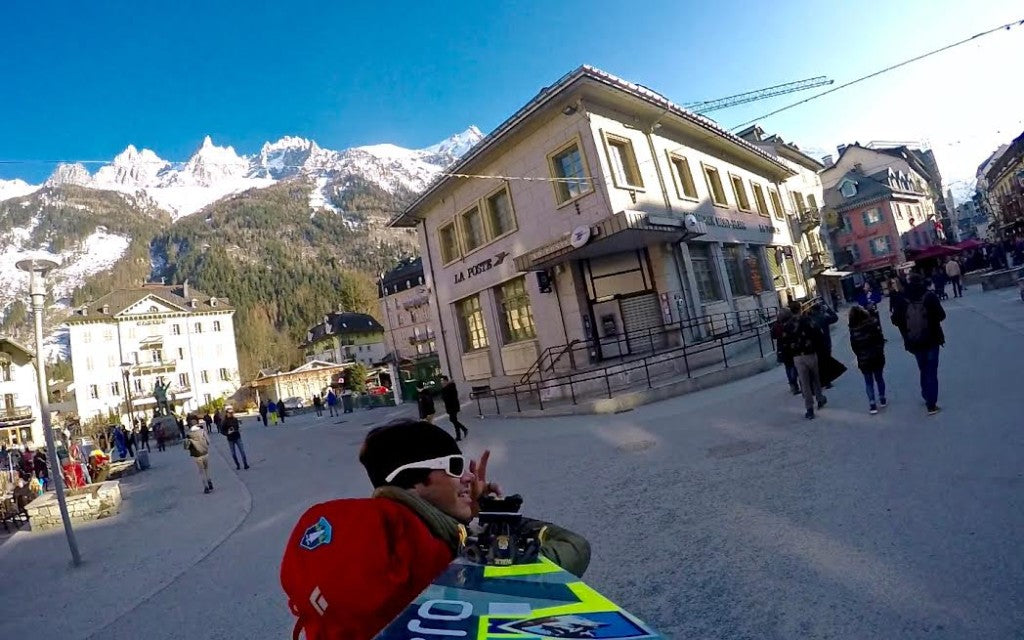 --Product Information--
Product Name:
--Product Information--
Product Name: Saga 40 JetForce
Product Brand: Black Diamond
Best Use: Guide, Multi-day Backcountry Touring
Sizes Available / Specs:
Materials: 840d Ballistic Nylon, 210d Ripstop Nylon, 315d Cordura®
Volume: 40 liters (M/L), 38 liters (S/M)
Weight: 3.5 kg./7 lb. 11 oz. (M/L) 3.4 kg./7 lb. 9 oz. (S/M)

 Full Review:
Full Review:
As the avalanche pack technology has advanced over the years, the ski and sled community has taken note. While nothing will ever take the place of knowledge and decision making, avi packs and other avalanche safety equipment has given those who travel into the backcountry a better chance at survival. Until recently, most backcountry any packs have meant you had to buy compressed air bottles and have them filled in order to operate the airbag. This is all fine and dandy if you have a fill station convenient to you or don’t plan on traveling to a ski or sled destination. Airline travel complicates things as you cannot travel with a full bottle. In comes the Black Diamond JetForce Technology. An avalanche airbag system that uses a battery and high RPM fan in order to fill the airbag used to help keep you afloat in a slide.
While met with mixed opinions at first, my opinion for this technology has been completely turned around and resulted in enthusiasm and trust in the product from Black Diamond. Due to my typical gear and activities in the backcountry (cameras, speed wing and harness, crampons, ice axe, skins, water, food, etc.) I opted for the larger Saga 40 pack. Black Diamond puts a claim at 40 liters on this version (in the M/L frame size) and it seems a bit small. Either way, it carries all of my gear and then some. The external helmet carrier helps with internal cargo space and the easily accessible pouch on top gives plenty of room for extra goggles, lenses, gloves, etc. The avi tool pouch gives the user immediate access to probe(s) and shovel with a single center mounted zipper. Since the main compartment access is a top feed making getting to bottom situated equipment more difficult, the back plate of the pack zips completely open to allow full access to the main compartment. Both top and rear access can be achieved without taking the waist belt off. The shoulder straps while thin and low profile are extremely comfortable and easily tighten and loosen thanks to the swing arm design. The waist strap is adequately padded and easily buckled and cinched. On one side of the waist band is a pouch for compass, GPS or bars while the other side holds the crotch strap in place when not being used. Skis are carried either horizontally or vertically and boards are carried vertically. Ice tools are easily and securely attached and there are multiple, secure carry/grab straps on the pack.
After charging the device from a depleted battery to full battery in 3 hours, the powering on/off and activation of the airbag is simple and straight forward. Once the handle is exposed on the skiers left shoulder strap, the red button is pushed which turns on the device. After a quick systems check the airbag is armed and ready to go with a green blinking light showing to let you know if the device is armed or not. Once you pull the handle, the fan kicks on and the bag is filled in about 3 seconds (manufacture claims 4, but my tests showed no longer than about 3). Once the bag is filled, it continues to cycle the fan ensuring that the bag stays inflated for about three minutes before going into a self-deflation mode. This deflation is meant to provide the user (if buried) with a sizable amount of space of which to breath or possibly begin moving and beginning self-retrieval.
After charging the device fully overnight, I completed 6 full cycles of the airbag over a two month period. After another full charge (3 hours) I completed 6 full airbag cycles in one day at a rate of about one per hour. This exceeds the claims of the manufacture of about 4 airbag cycles on a single charge. Additionally, I allowed myself to be partially buried in loose snow with the main intake vent of the fan covered and the airbag still inflated within 3-4 seconds (the system uses multiple vent areas around the bag to achieve inflation).
After several backcountry tours in the Oregon and Washington Cascades and a mixed bag of skiing and speed flying in the Mont Blanc region of the French Alps, the pack has proven to be a durable and versatile asset. Domestic and international airline travel is easy with the bag being carried on the plane with no issues in security. Not having to empty a compressed air bottle before flying then having to find a fill station on arrival is a major plus. Additionally, the fact that an accidental discharge or discharge in an actual slide doesn’t ruin your day on a backcountry or heli trip since repacking and rearming of the bag only takes about 1-2 minutes. This is a major plus since either of the aforementioned events could end the day on a heli or cat-ski trip without an extra compressed air bottle.
In all, I’ve thoroughly enjoyed this bag. The considerable higher price tag has been worth it with its ease of use and no hassle ensuring that the bag is always ready to go and not having to worry about compressed air bottle filling or problems with faulty gauges.
--Review Summary Points--
"The Good" List :
- Ease of Charging, Arming and Repacking
- Durable
- Comfortable
- Quick Access to Avy Equipment
- Ease of Air Travel
"The Not so Good List":
- Cost
- Questionable Internal Compartment Size
The Bottom Line:
Extremely please with this pack. After dealing with considerable issues in the past with air travel and refilling/gauge issues on compressed air avy packs, this pack is a blessing. While slightly heavier than my previous pack, it far outperforms it in almost every category. Black Diamond seems to be on to something with this design and, in my opinion, has hit the ball out of the park with this pack.

 --Product Information--
Product Name: Saga 40 JetForce
Product Brand: Black Diamond
Best Use: Guide, Multi-day Backcountry Touring
Sizes Available / Specs:
Materials: 840d Ballistic Nylon, 210d Ripstop Nylon, 315d Cordura®
Volume: 40 liters (M/L), 38 liters (S/M)
Weight: 3.5 kg./7 lb. 11 oz. (M/L) 3.4 kg./7 lb. 9 oz. (S/M)
--Product Information--
Product Name: Saga 40 JetForce
Product Brand: Black Diamond
Best Use: Guide, Multi-day Backcountry Touring
Sizes Available / Specs:
Materials: 840d Ballistic Nylon, 210d Ripstop Nylon, 315d Cordura®
Volume: 40 liters (M/L), 38 liters (S/M)
Weight: 3.5 kg./7 lb. 11 oz. (M/L) 3.4 kg./7 lb. 9 oz. (S/M)

 Full Review:
As the avalanche pack technology has advanced over the years, the ski and sled community has taken note. While nothing will ever take the place of knowledge and decision making, avi packs and other avalanche safety equipment has given those who travel into the backcountry a better chance at survival. Until recently, most backcountry any packs have meant you had to buy compressed air bottles and have them filled in order to operate the airbag. This is all fine and dandy if you have a fill station convenient to you or don’t plan on traveling to a ski or sled destination. Airline travel complicates things as you cannot travel with a full bottle. In comes the Black Diamond JetForce Technology. An avalanche airbag system that uses a battery and high RPM fan in order to fill the airbag used to help keep you afloat in a slide.
While met with mixed opinions at first, my opinion for this technology has been completely turned around and resulted in enthusiasm and trust in the product from Black Diamond. Due to my typical gear and activities in the backcountry (cameras, speed wing and harness, crampons, ice axe, skins, water, food, etc.) I opted for the larger Saga 40 pack. Black Diamond puts a claim at 40 liters on this version (in the M/L frame size) and it seems a bit small. Either way, it carries all of my gear and then some. The external helmet carrier helps with internal cargo space and the easily accessible pouch on top gives plenty of room for extra goggles, lenses, gloves, etc. The avi tool pouch gives the user immediate access to probe(s) and shovel with a single center mounted zipper. Since the main compartment access is a top feed making getting to bottom situated equipment more difficult, the back plate of the pack zips completely open to allow full access to the main compartment. Both top and rear access can be achieved without taking the waist belt off. The shoulder straps while thin and low profile are extremely comfortable and easily tighten and loosen thanks to the swing arm design. The waist strap is adequately padded and easily buckled and cinched. On one side of the waist band is a pouch for compass, GPS or bars while the other side holds the crotch strap in place when not being used. Skis are carried either horizontally or vertically and boards are carried vertically. Ice tools are easily and securely attached and there are multiple, secure carry/grab straps on the pack.
After charging the device from a depleted battery to full battery in 3 hours, the powering on/off and activation of the airbag is simple and straight forward. Once the handle is exposed on the skiers left shoulder strap, the red button is pushed which turns on the device. After a quick systems check the airbag is armed and ready to go with a green blinking light showing to let you know if the device is armed or not. Once you pull the handle, the fan kicks on and the bag is filled in about 3 seconds (manufacture claims 4, but my tests showed no longer than about 3). Once the bag is filled, it continues to cycle the fan ensuring that the bag stays inflated for about three minutes before going into a self-deflation mode. This deflation is meant to provide the user (if buried) with a sizable amount of space of which to breath or possibly begin moving and beginning self-retrieval.
After charging the device fully overnight, I completed 6 full cycles of the airbag over a two month period. After another full charge (3 hours) I completed 6 full airbag cycles in one day at a rate of about one per hour. This exceeds the claims of the manufacture of about 4 airbag cycles on a single charge. Additionally, I allowed myself to be partially buried in loose snow with the main intake vent of the fan covered and the airbag still inflated within 3-4 seconds (the system uses multiple vent areas around the bag to achieve inflation).
After several backcountry tours in the Oregon and Washington Cascades and a mixed bag of skiing and speed flying in the Mont Blanc region of the French Alps, the pack has proven to be a durable and versatile asset. Domestic and international airline travel is easy with the bag being carried on the plane with no issues in security. Not having to empty a compressed air bottle before flying then having to find a fill station on arrival is a major plus. Additionally, the fact that an accidental discharge or discharge in an actual slide doesn’t ruin your day on a backcountry or heli trip since repacking and rearming of the bag only takes about 1-2 minutes. This is a major plus since either of the aforementioned events could end the day on a heli or cat-ski trip without an extra compressed air bottle.
In all, I’ve thoroughly enjoyed this bag. The considerable higher price tag has been worth it with its ease of use and no hassle ensuring that the bag is always ready to go and not having to worry about compressed air bottle filling or problems with faulty gauges.
--Review Summary Points--
"The Good" List :
- Ease of Charging, Arming and Repacking
- Durable
- Comfortable
- Quick Access to Avy Equipment
- Ease of Air Travel
"The Not so Good List":
- Cost
- Questionable Internal Compartment Size
The Bottom Line:
Extremely please with this pack. After dealing with considerable issues in the past with air travel and refilling/gauge issues on compressed air avy packs, this pack is a blessing. While slightly heavier than my previous pack, it far outperforms it in almost every category. Black Diamond seems to be on to something with this design and, in my opinion, has hit the ball out of the park with this pack.
Full Review:
As the avalanche pack technology has advanced over the years, the ski and sled community has taken note. While nothing will ever take the place of knowledge and decision making, avi packs and other avalanche safety equipment has given those who travel into the backcountry a better chance at survival. Until recently, most backcountry any packs have meant you had to buy compressed air bottles and have them filled in order to operate the airbag. This is all fine and dandy if you have a fill station convenient to you or don’t plan on traveling to a ski or sled destination. Airline travel complicates things as you cannot travel with a full bottle. In comes the Black Diamond JetForce Technology. An avalanche airbag system that uses a battery and high RPM fan in order to fill the airbag used to help keep you afloat in a slide.
While met with mixed opinions at first, my opinion for this technology has been completely turned around and resulted in enthusiasm and trust in the product from Black Diamond. Due to my typical gear and activities in the backcountry (cameras, speed wing and harness, crampons, ice axe, skins, water, food, etc.) I opted for the larger Saga 40 pack. Black Diamond puts a claim at 40 liters on this version (in the M/L frame size) and it seems a bit small. Either way, it carries all of my gear and then some. The external helmet carrier helps with internal cargo space and the easily accessible pouch on top gives plenty of room for extra goggles, lenses, gloves, etc. The avi tool pouch gives the user immediate access to probe(s) and shovel with a single center mounted zipper. Since the main compartment access is a top feed making getting to bottom situated equipment more difficult, the back plate of the pack zips completely open to allow full access to the main compartment. Both top and rear access can be achieved without taking the waist belt off. The shoulder straps while thin and low profile are extremely comfortable and easily tighten and loosen thanks to the swing arm design. The waist strap is adequately padded and easily buckled and cinched. On one side of the waist band is a pouch for compass, GPS or bars while the other side holds the crotch strap in place when not being used. Skis are carried either horizontally or vertically and boards are carried vertically. Ice tools are easily and securely attached and there are multiple, secure carry/grab straps on the pack.
After charging the device from a depleted battery to full battery in 3 hours, the powering on/off and activation of the airbag is simple and straight forward. Once the handle is exposed on the skiers left shoulder strap, the red button is pushed which turns on the device. After a quick systems check the airbag is armed and ready to go with a green blinking light showing to let you know if the device is armed or not. Once you pull the handle, the fan kicks on and the bag is filled in about 3 seconds (manufacture claims 4, but my tests showed no longer than about 3). Once the bag is filled, it continues to cycle the fan ensuring that the bag stays inflated for about three minutes before going into a self-deflation mode. This deflation is meant to provide the user (if buried) with a sizable amount of space of which to breath or possibly begin moving and beginning self-retrieval.
After charging the device fully overnight, I completed 6 full cycles of the airbag over a two month period. After another full charge (3 hours) I completed 6 full airbag cycles in one day at a rate of about one per hour. This exceeds the claims of the manufacture of about 4 airbag cycles on a single charge. Additionally, I allowed myself to be partially buried in loose snow with the main intake vent of the fan covered and the airbag still inflated within 3-4 seconds (the system uses multiple vent areas around the bag to achieve inflation).
After several backcountry tours in the Oregon and Washington Cascades and a mixed bag of skiing and speed flying in the Mont Blanc region of the French Alps, the pack has proven to be a durable and versatile asset. Domestic and international airline travel is easy with the bag being carried on the plane with no issues in security. Not having to empty a compressed air bottle before flying then having to find a fill station on arrival is a major plus. Additionally, the fact that an accidental discharge or discharge in an actual slide doesn’t ruin your day on a backcountry or heli trip since repacking and rearming of the bag only takes about 1-2 minutes. This is a major plus since either of the aforementioned events could end the day on a heli or cat-ski trip without an extra compressed air bottle.
In all, I’ve thoroughly enjoyed this bag. The considerable higher price tag has been worth it with its ease of use and no hassle ensuring that the bag is always ready to go and not having to worry about compressed air bottle filling or problems with faulty gauges.
--Review Summary Points--
"The Good" List :
- Ease of Charging, Arming and Repacking
- Durable
- Comfortable
- Quick Access to Avy Equipment
- Ease of Air Travel
"The Not so Good List":
- Cost
- Questionable Internal Compartment Size
The Bottom Line:
Extremely please with this pack. After dealing with considerable issues in the past with air travel and refilling/gauge issues on compressed air avy packs, this pack is a blessing. While slightly heavier than my previous pack, it far outperforms it in almost every category. Black Diamond seems to be on to something with this design and, in my opinion, has hit the ball out of the park with this pack.

